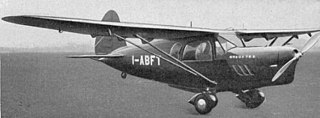The IAR 14 is a Romanian low-wing monoplane fighter-trainer aircraft designed before World War II.

The SZD-45 Ogar (Greyhound) is a T-tailed cantilever high-wing monoplane of wooden, aluminium and fibreglass construction designed and manufactured in Poland.
The Arpin A-1 was a two-seat low-wing monoplane which was powered by a single radial engine in pusher configuration, mounted behind the cabin between twin booms that carried the tail. An unconventional fixed tricycle undercarriage was fitted. Only one was built.

The SAIMAN 202 was a 1930s Italian two-seat cabin monoplane designed and built by the Società Industrie Meccaniche Aeronautiche Navali (SAIMAN).

The RWD-11 was a six-passenger feeder-liner designed and built in Poland from 1932.

The Breda Ba.79S was a single-engine four-seat high-wing private aircraft built in Italy in the late 1930s. Only a few were produced.

The CANT Z.1012 was a small three-engined monoplane built in Italy in the late 1930s to carry either three or five passengers depending on the engines. A small number were built for Italian diplomatic use.

The Praga E-210 was a four-seat, twin-engined touring aircraft built in Czechoslovakia in the late 1930s. It had an unusual pusher configuration. Its tail unit and undercarriage were modified significantly before World War II and after the war a more powerful version designated E-211 was flown.
The Pasotti F.6 Airone was a low-wing, twin-engined, wooden, four seat civil aircraft built in Italy in the 1950s. Production was considered but only one was completed.
The ICA IS-23 was a single-engined high-wing monoplane with STOL capability that was built in Romania in the 1960s. It was developed into the similar ICA IS-24.

The I.S.T. XL-15 Tagak was a single-engine, twin-boom, high-wing monoplane designed after the I.S.T. XL-14 Maya and built in the Philippines in the mid-1950s. The result of a collaboration between a Government research institute and the Philippine Air Force, it was designed as a utility, liaison or ambulance aircraft and as a test bed for the use of local materials in aviation.
The I.S.T. L-17 Masang was a two-seat, single engine, low wing monoplane aircraft designed and built in the Philippine Republic in the mid-1950s. It was intended for both touring and training.

The Timm T-840 was a twin engine, high wing passenger aircraft designed and flown in the United States in 1938. Equipped with a tricycle undercarriage and low speed aerodynamic devices, it could be configured to carry between six and ten passengers. Only one was built.

The CNA PM.1 was a single-engine light sport and training aircraft designed and built in Italy at the start of World War II. After tests of the prototype a small production run was laid down but destroyed by bombing.

The Savoia-Marchetti SM.80 was a two-seat monoplane amphibian tourer, with a single, tractor engine mounted above the wing, designed in Italy in the early 1930s. The SM.80bis was a four-seat variant, powered by two pusher engines.

The Aviamilano F.14 Nibbio is a four-seat, single engine cabin monoplane built in Italy in the late 1950s. Only ten production aircraft were completed.

The Sud-Est or SNCASE SE-2100, sometimes known as the Satre SE-2100 after its designer, was a tailless, pusher configuration touring monoplane with a single engine and cabin for two. Only one was built.
The ViS Sprint is a pusher configuration, pod-and-boom two-seat ultralight, designed and built in the Ukraine in the mid-2000s. It can serve as an agricultural spraying aircraft.
The Chasle YC-100 Hirondelle (Swallow) is a French single seat microlight designed in the 1980s.
The WNF Wn 16 was an Austrian experimental aircraft built near the start of World War II to test the properties of the then-new tricycle undercarriage arrangement.












